|
IMAGING BEIJING |
|
Blog On Jan 17, 2008, at 1:20 PM, Gregory Ulmer wrote: Hi Craig Very good response to Amy's questions, and filled in some new info for me. About psychogeography, there is more in the new book, but for now I would just add, or clarify very briefly a couple of points, in part to advertise the pedigree or tradition of choragraphy. 1--psychogeography is a precedent for our exploration of choragraphy, which may be understood in one way as a retrieval of SI experiments for electracy. 2--a primary interest, motivated by choral theory, is the role of mood/atmosphere as categorial in new media settings. The SI tested possibilities of traversing the city form following not conventional maps but the hubs of mood. 3--a possibility tested in Imaging Place is the capacity of atmospheres to sustain moods, and these in turn function as attractors of attention and focus, with important implications for ethics and politics of cyberspace. 4--SL provides ideal conditions for testing mood as primary interface. yours Greg What is Felt? Very simply, felt is matted wool. Wool becomes felt when it is subjected to moisture, heat, and pressure. In fact, if domestic sheep were not shorn, over time their wool would felt or "cot". Hot soapy water makes the wool slippery, and causes tiny scales on the fiber to open up. The scales prevent the fibers from backing up again after they slide across each other. With agitation, the fibers get hopelessly tangled together. When cooled and dried, the scales close and lock the wool into the tough, durable material we call felt. On Jan 17, 2008, at 9:32 AM, John Craig Freeman wrote: Hi Amy, These are interesting questions. I will do my best to respond here and then float them to my colleague Greg Ulmer. What I have to say here is largely based his theoretical work and our collaboration over the past decade. The original approach was to distribute the various Imaging Place scenes around the Second Life grid so that as you moved from one Imaging Place location from around the world, you would also be moving around the virtual world of Second Life. This proved to be to costly to sustain for now, but it remains an important experimental principle in my work. When I was invited to exhibit in the Place Relations exhibition, at the Kunstraum Walcheturm during the Digital Art Weeks in Zurich last summer, it was necessary for me to consolidate the work into one location so that I could strand JC there. JC acted as the user interface for the visitors to the gallery space. Allowing people to fly all over the SL grid would ruin the installation as a work of art. So I striped down the interface so that JC could not fly or teleport out of the Imaging Place work, and that is where the work remains for now. Although I will be exhibiting the new Imaging Beijing work this February at Ars Virtua as part of Turbulence.org's Mixed Realities project. In the long term I am developing my own social networked virtual world to house Imaging Place. The idea will be to distribute access points to specific Imaging Place locations across the space of the internet itself, for instance place markers in Google Earth. As I understand it the Situationist were developing the idea that moving through space, ie the dérive, was an act of reasoning, that thinking itself was spacial in nature. Moving from one idea to another by way of association was like moving through space from one point to another. In my work I try to capitalize in the inherent drifting of avatars through a virtual experience by providing the equivalent of the Situationist's plateau tourné, the vortex, turntable or hub. I do this with the panoramic imagery which is represented in various iterations of the Imaging Place as the node. The nodes are organized into complex scenes we call chora, which is similar to the zone in pychogeography. I would say that the reemergence of interest in psychogeography is related to the migration of public space from the physical town square, so to speak, as it fell victim to corporate privatization, to the internet and then back out again into the physical world in the form of locative media, network mobilization and ubiquitous computing. Ultimately virtual worlds like second life are only a way station in the transition from linear to spacial reason. There still needs to be a reflection of spacial reason from the virtual experience to that of the physical world. This is where the notion of mixed realities enters the discourse. Laying Out the Wool Lay out a half-ounce of washed and carded wool. Divide into three equal portions. Spread out the first portion so that the wool evenly covers the bottom of a cake pan, with all of the fibers running in the same direction. Place the second layer on top of the first with the layers at right angles to the layer beneath. Repeat with the third layer, arranging the fibers cross-ways to the layer below. On Jan 16, 2008, at 2:12 PM, Amy Elias wrote: Hi Craig, I'm finishing that article for PMC, and am citing Imaging Place as an example of psychogeography in Second Life. The blurb I got on it through SL, however, said that the project has numerous SL locations. Is that correct? Or is everything in SL on Emerson Island now? If you want to comment on these questions, that would be great: 1. In your opinion, what is the importance of Situationist ideas, particularly psychogeography, to Second Life? Or, the other way around, in what ways might SL realize, modify, or supplement Situationist concepts such as psychogeography? 2. Why is psychogeography, a concept popularized more than 40 years ago, back and important to research such as your own? Thanks! Amy Wetting the Wool Squirt a small amount of liquid detergent over the top layer of wool. Then gently pour about a half cup of hot water over the wool. On Jan 19, 2008, at 2:59 PM, John Craig Freeman wrote: On Eliciting Testimonials Point 1. I have discussed this with the denizen I have worked with extensively and I keep them apprized of developments as best as I can, but I do recognize that the implications are extensive. My thought about the larger issue, is that although ones willingness to put his or her personal life out on public display might have been a uniquely U.S. phenomenon in the past, it seems to be part of the identity formation shift which you predicted early on, and is now spreading as a defining characteristic of globalization itself. This is evident for example, not only on the social web, but in reality TV and the acceptability of cosmetic surgery even. We are becoming avatars. Drunken naked party pictures on our student's MySpace pages only become a problem when they come into conflict with literate institutions, such as corporate culture. It wont be long until the electrate are doing the hiring. So, in my mind, uploading our private lives - willingly giving our "selves" over to the network, is THE sign of emergent identity behavior online, specific to electracy. Of course we have to add celebrity. In the Ulmer Tape you made the prediction that the 'self' gets replaced by the 'image' in electacy, as in celebrity look-a-like shows. Your academic degrees no longer matter as much as your Google hits, and the web allows everyone to craft their own sense of celebrity, or should we say micro-celebrity. On Eliciting Testimonials Point 2. Okay, This is where the sledge hammer meets the hutong wall. The mood of the movement from Xizhimen Station to the demolition zone was framed by morning the loss of ancient cultural heritage on the one hand, and optimism for a brighter more livable future on the other, simultaneous attraction and repulsion, ambivalence based in public policy. Although this was very apparent to both Chang and I during the process, I feel this particular testimonial is so successful, because Chang never addresses the issue directly, at least not until we were standing in the rubble. The place was allowed to speak for itself. In stead he focused on truly formative memories including domestic violence and sexual transgression, a true memory map. So what we need to do, or perhaps what we need to design Ka Ching to do, is to connect the formative memory to the effects of the public policy. Is this correct? Does this get us to mood? Some of it may be to simplistic. Chang's dad hits him and he doesn't know why and would never ask. The government demolishes a neighborhood and no one asks why. But I suspect that there is something more complex and subtle going on here. Interestingly Weinberger used Heidegger's hammer example to talk about the semantic web. Does chora amount to the semantic situation? On Eliciting Testimonials Point 3. As you are considering further suggestion on the switch from the direct memory anecdote to the circumspection of a figure, please think of some practical techniques that I could try out in the field while working with future denizens. Pressing Down the Wool Press straight onto the wool pile so that the wool compresses into a mass on the bottom of the pan. Add more hot water until all of the wool is wet. Work around the edges, pressing down until all of the wool is matted down. On Jan 10, 2008, at 10:54 AM, Gregory Ulmer wrote: On eliciting testimonials: The question about dialogue with the denizens is especially relevant in the context of a global projection of Imaging Place. A framing observation is that the testimonials should not require understanding of the motivating theory (we can discuss this point further). 1. I was reminded when doing a mystory workshop in Australia some years ago that telling personal anecdotes is a specifically American (U.S.) turn. The Australian students more or less refused to complete the Family part of the popcycle. We should keep in mind the culture-specific status of privacy and personhood in using the Internet as a support for the KaChing (decision gate). At the same time, I wonder what the effect on other cultures is of the common practice in social networking venues of confessional copia? Two vernacular practices that would benefit from an electrate rhetoric are: confession; appropriation. Much of what is posted online seems to fall into one or the other of these genres. We know that identity construction is part of an apparatus, and that ???selfhood??? is an identity experience/behavior specific to alphabetic institutions. We should be looking for signs of an emergent identity behavior online, specific to electracy, that might be tested with the testimonial. 2. Lessons of flash reason? My recent extrapolation of a poetics from the history of image reason during the epoch of literacy suggests a possible alternative to directly personal anecdotes (not to replace memorial anecdotes, but to supplement them, or perhaps to stimulate them). The importance of the denizen is confirmed in this recent research, in that the choral measure is shown to be singular and mobile. Each person is a (temporary) category, a mise-en-abyme whose passage through a scene configures circumstances into a (existential) situation. The flux and turbulence of complexity at any moment means that a scene contains a sublime or infinite number of possible features. The theory proposes that for a denizen, however, the chaos is already a chora, that is, an order, with all the elements showing one possible face for that person. In the West, since Aristotle, things mostly put on their tool face (Heidegger). Other faces are available. (Face is to felt what voice is to text). These faces show themselves at a pre-individual level, and do not necessarily lend themselves to narrative. The more relevant formal device is a poetic image in the family of epiphany, such as the objective correlative. The interviewer would not solicit a poem (but the method could be explained as being like poetry). S/he proposes the possibility of figurative thinking. What feature(s) of the present circumstances could be a metaphor for the denizen???s feeling, state of mind. It could be a metaphor of a remembered state, the one most typical of the denizen???s childhood experience, for example. The memory itself might then be expressed (or not). If the purpose of the testimonial was to measure the atmosphere of the scene, then the figure selects those features of the present scene that best correlate with how the denizen feels in that moment. 3. In short, the direct memory anecdote is supplemented with the circumspection of a figure. There is some tradeoff in this switch. The advantage of using properties of the zone scene as metaphor/allegory is that the connection between present/past, outside/inside, is accomplished by the denizen, rather than (exclusively) by the mystory structure. This practice remains to be tested. I have some further suggestions for another memo. 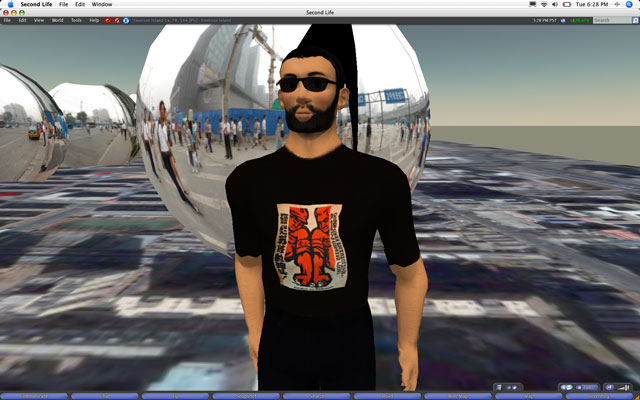
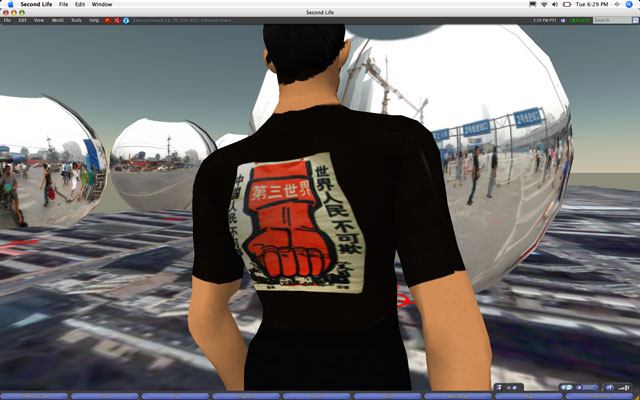
Working the Wool Hold the pan in one hand, while you gently massage the edge of the wool with the fingertips of the other hand. Use your palm to gently agitate the center. Slowly rotate the pan as you work. Keep rolling the edge of the wool slightly inwards to give it a smooth, finished shape. The soap will squish up between your fingers and the wool will matt togther. After about 5 minutes the wool will begin to firm up, and you can begin to work with a more vigorous circular motion. On Jan 19, 2008, at 11:58 AM, John Craig Freeman wrote: Okay, I think I have a chance to catch up on our exchange today. I agree with your point here about not ditching our arts and letters methodologies in favor of scientism. I do think it is imperative, however, to look closely at chaos for practical reasons relating to how we order our world in electracy and ultimately how we will organize the Ka Ching. Last year we had David Weinberger during the Floating Points lecture series, where he gave a version of his his "Everything is Miscellaneous" stump speech. He talked about what happens when we lose the constraints of the physical when we organize ideas, information and knowledge in a digital network. He makes the case that chaos is preferable to carving nature up at the joints. Turning the Felt After about 10 minutes, the felt will hold together well enough to turn it over. Tip the pan and gently flop the wool out into your hand and place it upside down in the pan. Add more soap or hot water if necessary, and continue working the wool as before. On Jan 6, 2008, at 12:13 PM, Gregory Ulmer wrote: Hi Craig, I gleaned a few questions you posed or implied from the blog. Let me formulate some thoughts on those and then we can schedule a chat. One thing to keep in mind about flash reason is that the whole thing is a prequel to Miami Virtue and our more recent work. It is the theoretical and historical rationale supporting the approaches we have employed regarding choragraphy. I was open to other or new possibilities during the research, and indeed some extra dimensions did emerge, such as the relevance of chaos. On that point, we need to clarify our positions as not ditching our arts and letters methodologies in favor of scientism. Rather, we are using the popularizations as guiding images to coordinate our theoretical resources with innovations in science and technology. In any case, the upshot is that the myStory, wide image, choral heuretics used in Miami and Imaging Place have been confirmed and strengthened by the more recent sweeping historical research of flash reason. The caveat is that I was the one doing the survey, and I may have filtered things a bit to make chora come out to be historically inevitable ;) best Greg Rinsing Run warm water into the pan and pour off the soapy water. Then run cold water over the wool and press the water out of it. It should be round, about an eighth of an inch thick, and a little smaller than the pan. If you continue working it, it will grow thicker and smaller. Its not that you are losing wool, its that you are losing air spaces. Fulling the Felt If you want the felt to be strong, continue working the felt by running more hot water over it, and rolling and squeezing it in your hands. The more you do this, the "fuller" (thicker and stronger) it becomes. On Dec 31, 2007, at 9:06 AM, John Craig Freeman wrote: Okay. This is probably too literal, but I put these diagrams together to help me organize my thinking on this. The Yin Yang of I Ching is replaced by binary digits with all of the fifteen dimensions of string theory, xyz of space plus time and the eleven predicted dimensions. 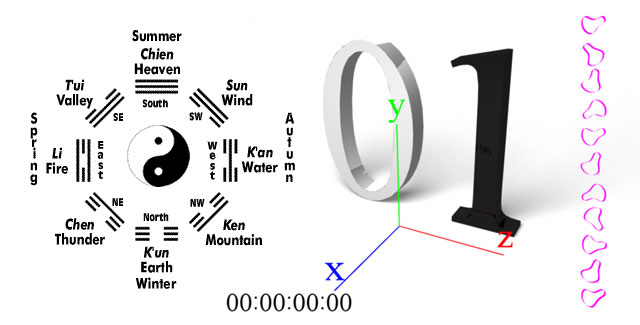
 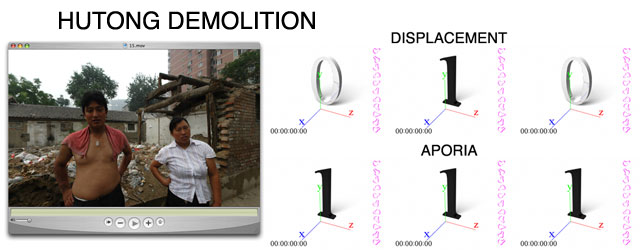  On Dec 30, 2007, at 2:58 PM, Greg Ulmer wrote: Nice. Amazing correlation with Pythagoreans and the vibrating string as the cosmic measure (referring to musical strings of course). Much of my current work with chora is to understand/construct a measure function to guide inference. The oblio series is about choral measurement. String physics suggests a return or retrieval of more ancient cosmologies, passing through modernist sublime with its disjunctive ratios (which I think of as chaotic, meanning having an order but a strange order, formerly thought of as "formless"). I need to read up a bit more on this. There are many pop introductions to chaos, if not to strings, which is good as indicator that this account, counter-intuitive for traditional physics and math, is on the way to becoming common sense. What is great for electracy is that it took the computer to notice the patterns: Edward Lorenz, a meteorologist. A virtue of Google just occured as well, speaking of random structure. I entered Konrad Lorenz, rather than Edward, for my first search, and got the inventor of ethology (Nobel Prize winner). Great, since I am teaching Deleuze's brief intro to Spinoza, with an excellent concluding chapter, using ethology as an analogy for the implications of Spinoza's insights into behavior (ethics). Very relevant to flash reason. Best Greg On Dec 30, 2007, at 12:02 PM, John Craig Freeman wrote: Yes, I agree with Greg. We have been using the blog to gather the pieces together and now it is time to get to work. What I propose is that we focus on the Beijing work, for starters, as the raw material and use chaos theory of turbulence as the sizing to shape it in to a extra-dimensional image. If successful this image should constitute one of the archetypal situations of electrate metaphysics. When is a good time to vidcon again Greg? On Dec 29, 2007, at 7:50 PM, Greg Ulmer wrote: We are on the same screen with this. After the new year (wishing y'all a happy one!) Craig and I can hook up what we already have and pass it along to you for further dissemination? We agreed that distributing pieces throughout a larger context is a nice concept. Perhaps we could propose a a set of pieces for you to work with? Craig, we probably need to have another chat about this, in January. Best Greg On Dec 28, 2007, at 5:57 PM, Elisabeth Tonnard wrote: Hi Greg and Craig, Coming back to the image process literature contribution, after seeing the updated blog I wonder if it would be possible to specifically set aside a certain aspect of your bigger project for the book. The felt image is the governing metaphor for the database, but it can also be seen in your discussions of the project now; like a mise-en-abyme. Maybe the book contribution could be a sort of smaller image then of the final project. Instead of showing the contents of the final project, the book could show the (re)search/dialogue/process itself as felt/associative patternmaking. What do you think? Seen in this way, much of the content seems to be there already in the videoconference. It's mainly the form that would have to be shaped. As you say felt can be shaped into different forms, so we might think about ways to show on paper the various spatial facets of your dialogue (for instance see if a pop-out would be possible). Wishing you a happy new year, Elisabeth On Dec 30, 2007, at 11:45 AM, John Craig Freeman wrote: Was the I Ching developed to study weather patterns, like an almanac? So are you suggesting that weather simulation models are a better approach to accessing the data base than meta data searches? I could see this. When the user consults the site, it would initiate a simulation of sorts. Hmmm! Your comment about making felt hat struck me because, well, I got one for Christmas, and the hat is three dimensional rather than two. From the very beginning of our work together I have been try to create an image that has additional dimensions, an image that you can enter, navigate and become immersed in.  As far as the list of things that we want to include in the felt project, here are some thoughts. One of the things that I would like to solve is how do I elicit mystorical testimonials from the denizens of the zones with out them understanding the complexity of electracy or the popcyle. As you know, his is difficult even for graduate students. I have be wrestling with since our original work on the Miami River. The Miami River worked because Barbara Jo provided the mystorical testimonial. I have tried playing that role myself, which worked for testing, but a long term solution is to have the denizens provide the mystory. Do you agree? I think that I am on to an approach, but it is really hard. Please consider Chang's testimonials with this in mind. Also we should work on determining if we are achieving representations of eletrate archetypal situations in the various projects, and if so, can they be articulated. Do the trigrams act as a relay for the patterns you are asking about? If so, can we start to get them listed, ie migration, displacement, aporia, etc. The more I look into chaos theory the more I see that it is a perfect relay for us. I am imagining the zones being made up of a turbulent topology of strange and basin attractors, where the denizens' testimonials represent the basins and public policy represents the peeks. I am also trying to draw a connection between chaos theory and the ten or eleven higher-dimensional objects or branes, which are predicted by string theory. Have you looked into this at all?  On Dec 27, 2007, at 11:13 AM, Greg Ulmer wrote: Ah, I got my connectivity back. Yes, these clips work, or at least make sense. Nice: we got much more out of that first chat than I anticipated. It is good to work with technically competent people! I was thinking while watching the bit on turbulence that those theories originated with the use of computers to study weather patterns. Just like the I Ching! Best Greg I finally managed to get together with Greg Ulmer via video conference to theorize the work and to develop more robust, ongoing communications. I have been interested in doing this since I left the University of Florida in 1999, but we were never able to pull it together until now. Using this basic technology should allow us to resume our collaboration at the intensive level we achieved in the late 90s. I have posted the exchanges below. I will work to improve the audio quality and download times in subsequent recordings. 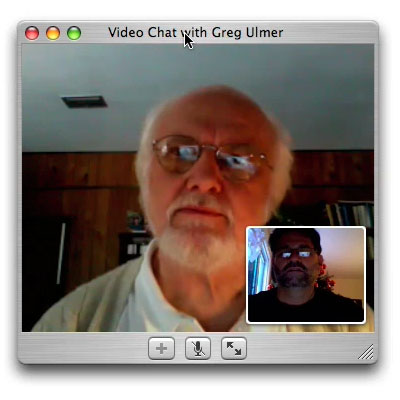 2007_12_21_02: Here, Ulmer posses a question about the recognition of patterns in the various "Imaging Place" projects using the I-Ching as a relay. Whoops! I didn't save the audio for my voice, so I just cut it out. No big loss for now. 2007_12_21_03: Ulmer continues explaining how in archaeology a grid is used to study a shipwreck, how the I-Ching achieves a similar overlay on empirical experience, and he suggest that we might develop a similar tool for our own time and experience. 2007_12_21_04: Ulmer suggest that we might look to chaos theory as a relevant relay. This is the first time that I considered this possibility and I find it very exciting. The problem is that I have a very pedestrian understanding. I will look into this in more depth and respond. My response to the question of patterns went something like this... One example of patterns that emerge in various projects is related to public policy. For instance, in Beijing, the pubic policy dynamic which was in play had to do with the government crafting an image of China as a 21st century supper-power, just in time for the Olympics. "Imaging Beijing" attempts to peal back the veneer of that image to expose its underbelly. Where as, "Imaging São Paulo," dealt with the mass migration of rural people to the city, a pattern that is repeated across the developing world as globalization puts these farmers in direct competition with industrial agribusiness. They simply cannot compete and are forced off the land and into the city in search of work. 2007_12_21_05: Ulmer suggest that we untangle all of the threads the various situation. He uses Heidegger's notion of ereignis, the event, as an example where all of the individual decisions that the denizens make are limited by cultural epistemology. A larger decision has already been made on their behalf. Our goal would be to make a data base that could make ereignis explicit. On Dec 15, 2007, at 12:47 PM, John Craig Freeman wrote: Hi Greg, Well, I have a couple things. I have been mostly focused on the technical development side of the work rather than the conceptual content, but maybe it can still be a point of departure. First, I added the images of communist graphics for sale in Yandaixiejie to the 2007-06-28 page of the web site that I am developing for the Turbulence.org "Mixed Realities" exhibition of Imaging Beijing. I find these images to be especially ironic, but poetic. I would be interested in your response. I also developed a good script which will open the users browsers to the dated entries when they click on the dates in Second Life. 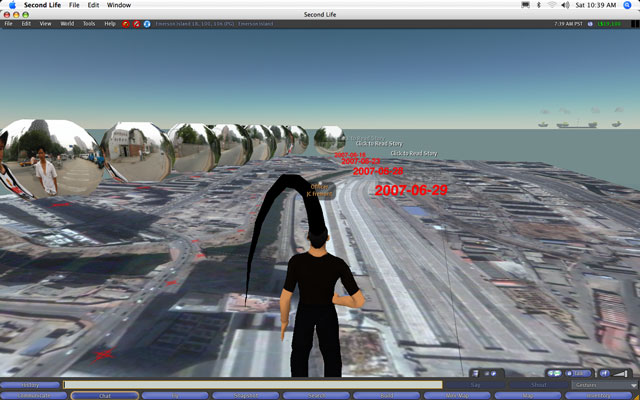 The next thing is that I worked out a method using a browser application called wKiosk to restrict the gallery audience to the Imaging Beijing database. This will keep them from general web browsing on the exhibition computer. 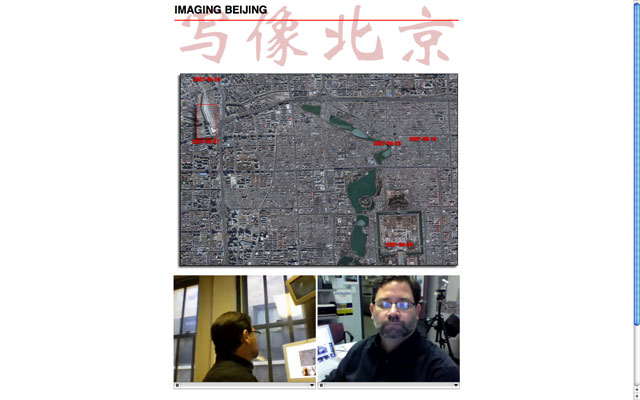 Also, as you can see here I am configuring two web-cams. One will be used to project the face of the person navigating the project in the gallery onto the JC Fremont avatar. This is the same method I used in Zurich at Der Kunstraum Walcheturm during the "Place Relations" exhibition. 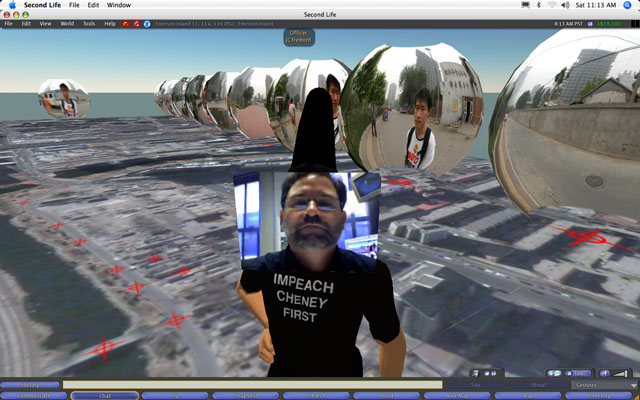 The second web-cam will place the user between the web-cam and the projection of Imaging Beijing in Second Life. The effect from the web-cam's perspective will be that the user will appear to be in Second Life, or in Beijing in this case. Here are some images of the contraption I am building which will act as the physical interface. 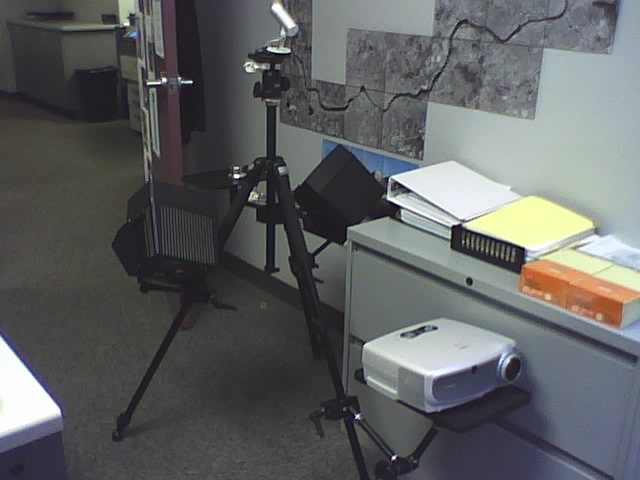 On Dec 13, 2007, at 3:28 PM, Greg Ulmer wrote: Hi Craig, Do you have time to give me something for the felt, to think about over the break? I haven't heard any complaints from those folks, but I don't know what the timing is either. btw, I have ichat video now. YOu and I should do a chat at some point just to catch up. best Greg On Oct 30, 2007, at 11:44 AM, Chang wrote: Hi Craig, My friend said it was a fascinating passage but that he had no idea whether it's authentic or not lol. He also said it fits quite well with the "characteristically whimsical fashion in which Eastern people, especially Chinese, tend to reason". I think there may be some truth in this. Perhaps a lot of modern-day Chinese conventions, norms and concepts are such that, when looked at from an outside perspective, they seem almost as arbitrary and incomprehensible as the taxonomy quoted by Borges. Must give this more thought though. Best, Chang On Oct 20, 2007, at 4:23 PM, Elisabeth Tonnard wrote: If we look at the hooks-and-eyes movement with the catching of particles, that is also a visual phenomenon; of particles mirroring eachother, not just in sound, but also in appearance. It would be interesting to visualize the hooks-and-eyes movement on the page, showing what's behind the scenes of the pun, creating an interlocking pattern of positive/negative-hook/eye columns down the page. The figurative meaning applies to German, but also to Dutch (and maybe more of the Nordic languages?). In Dutch the word is "scheppen" which could apply to water or sand or any matter that one scoops up; and it also means "to create". Ciao! Elisabeth On Oct 19, 2007, at 5:54 PM, Greg Ulmer wrote: The first thing that comes to mind in response to this sample is that "felt" isn't "processed" quite so directly. Felt differs from weave of text (the semantics and syntax of written grammar) by an associative hooks-and-eyes catching of particles. There is non-objective dimension, that theorists have called the "Rat Bridge," with reference to Freud's Rat Man case study. Freud himself called it the "verbal bridge" that he noticed in the case, and in others like it: that thought moved along a path not always of semantic links, but of sound associations, and beyond that: a pattern of paronomasia, or of shared syllables. I have called this a puncept: a gathering (logos) of signifiers by shared letters and or sounds. It is "joyceing" in its macaronic nature across languages. So in the example in the blog, the historical root of the Chinese word, translated into German, carries a figurative meaning. The "passage" is from drawing-water-out-of-a-well to town to German drawing-out to German creative process. By extension, anything that happens in the Chinese town, documented in Craig's mapping, has relevance for a poetics of the creative process. The method moves from sense into nonsense, then resurfaces, or reappears as newsense. Andiamo a Italia! Greg On Oct 19, 2007, at 3:38 PM, Elisabeth Tonnard wrote: Hi Greg and Craig Great to see the two of you are moving along! Looking at the blog I thought it might be a good idea to reflect a bit more on what we understand as 'image process literature,' since that question popped up. The book will showcase new approaches in the field of visual literature and digital poetics; and use image processing as the basic metaphor for binding them together (compare to how Bowles and Russell used the movie metaphor in 'This book is a Movie'). There are all sorts of forms of image processing. Literature could be physically processed as visual material (for instance texts that are shredded, or cut, or literally processed to paper pulp) or put through a metaphorical black box where the image itself processes literature as a computer word processor would process a text, or we can think of graphic models that render literature visible in the manner of information visualization and imaging (a good example is the notion of sparklines as described by Tufte: small, intense, wordlike graphics. Or Franco Moretti's Graphs, Maps, Trees - using visualization as unique, graphic approach for literary studies). In your case, felt would be the processing agent. Best, Elisabeth On Oct 11, 2007, at 11:13 AM, Greg Ulmer wrote: Hi Craig, A question, soliciting your speculations regarding how to implement our plans for the Internet Oracle, the KaChing, as an experiment in choragraphy. My question assumes this oracle project, but I am open to suggestions for other delivery frames. My continuing interest in the oracle frame is that in my recent research, working on the book (Flash Reason Against the Internet Accident), turned up a refrain, featured especially in Heidegger: the citation from the fragments of Heraclitus, stating that the oracle at Delphi niether shows nor hides, but intimates. Intimation is the kind of sign that holds most promise for electracy. The heuretic method, as you know, extracts production plans from "relays" (existing practices that point us in the right direction). The I Ching is an especially relevant relay for us. I will review several of its features, keeping in mind the Nietzschean instruction, to always ask "what is that for me, in my situation?" Another proviso is that our update would not be a pure appropriation, but an adaptation with syncretic motives (to address a global civilization). What is "wisdom" today? The feature of the I Ching that most interests me in this question is its reliance on landscape as its primary interface metaphor, that makes the consultation intuitively intelligible to anyone in that civilization. The The landscape is rural, and complete, so to speak, having the look in imagination of the masterpieces of Chinese painting. Chinese painters in any case over the centuries codified nearly every attribute of the terrain, flora, fauna, to create an iconic "language." The trigrams of the oracle articulate the landscape into eight features, or four pairs (heaven-earth, mountain-lake etc). In addition, the landscape is understood to be moving through time (the four seasons). This primary interface is then correlated with a series of other systems of the society and culture -- the human body, the family, the historical dynasties. That correlation leads into some other questions. The question here asks about how to think about the "imaging place" sites with respect to this relay? Our updated interface is a cityscape, urban not rural, industrial and even post-industrial, not agricultural. Certainly moving through time (the Web of Changes) but not with the rhythms of an agricultural economy. What are your thoughts about the intuitive intelligibility of these cityscapes? How might these places be articulated into a correlative by means of which to organize the other systems of our world (or not)? Greg On Sep 19, 2007, Greg Ulmer wrote: 1. The "Imaging Beijing" project focuses on the demolition of traditional neighborhoods to make room for the "new" China. These neighborhoods, often referred to as hutongs have a rich history reaching back hundreds of years. The word hutong comes from the Mongolian hottog meaning "water well." How to think together China/USA? Electrate image categories jump, to form blocks. Juxtaposition. Follow the conduits of natural language, macaronically (puns across languages). This is "Joyce-ing" according to Kenneth Burke, using the linguistics of the Wake. A craft of joinery, for time out-of-joint. Heidegger works the hinge, but Derrida pulls the pin and the grammes float apart. A logic of joists. Such is my point of departure, just having been diagnosed as needing a hip replacement. The X-rays show it: the joint is gone (bone on bone): a Derridean hip. In this case the joint is semantic: water well. Let this word and thing be the set-up (frame), for a temporary category, to gather what it may. Hutong. Our theorists play with the German version: Schopfen means "drawing water from a well," and is related by paronomasia (a favorite device of our theorists) to Schopfung, "creation, created things, production." The critical lesson of this joint is that you and I are authorized (required) to draw the significance out of this source (activate "drawing" in all senses). Meaning is mobile, comes and goes, follows a path, conducts a passage through materials, matter(s) -- language, photographs, documents. We may think of Cezanne's "realization" of certain motifs, or the distinction between the potential and the actual in Aristotle's metaphysics. 2. An image category has much to learn from Chinese logos, the way of gathering native to Chinese language and culture, characterized negatively or in an orientalist way in Foucault's much cited citation of Borges's Chinese encyclopedia, "in which it is written that 'animals are divided into: (a) belonging to the Emperor, (b) embalmed, (c) tame, (d) sucking pigs, (e) sirens; (f) fabulous, (g) stray dogs, (h) included in the present classification, (i) frenzied, (j) innumerable, (k) drawn with a very fine camelhair brush, (l) et cetera, (m) having just broken the water pitcher, (n) that from a long way off look like flies" (Michel Foucault, The Order of Things). A Sinologist explains that this list in fact expresses a classification system native to Chinese metaphysics. The list is ordered by an attunement, shi, that is self-evident to natives. "it is as if the Chinese using the lists would have no need to derive a more abstract concept from the material instances, as if they had no need for any theory over and above what they could themselves instinctively and actively feel to be the pertinence of shi through the cases listed. For them, shi was a practical -- indeed the most practical -- term and one to be considered as such. Shi is self-evident, permeating whatever field one considers, and as soon as one is exerting oneself effectively and educating oneself in an apprenticeship, the very idea of explaining shi becomes pointless" (Francois Jullien, The Propensity of Things). Shi means disposition, circumstance, power, potential, referring to the tendency or propensity of the energy of change operating in any situation. It entered Western culture in the twentieth century through such practices as I Ching divination, Feng Shui, and Tai Chi. It turns out that the Borges list resembles those produced to render the fingering positions for playing the lute, or the moves for a martial art. 3. In designing a category for an image metaphysics, appropriate for an electrate apparatus, we have returned to chora, proposed by Plato in Timaeus, to account for the relationship between the two dimensions of his cosmology: being (the Forms, essences of the real) and becoming (changing phenomena of the lived world, the unreal). The seat of exchange, the hinge between macrocosm and microcosm, was the human body. Chora may serve electracy the way topos served literacy. The more regional (rather than local), holistic reach of the former is better suited to digital gathering. Choral gathering begins with an actual site, a place and time, such as this hutong in China. The demand that a category connect the general with the particular is addressed by selecting in the site a zone registering a policy dilemma, a collective aporia (a no-way). The universal singular conduit (as above, so below) is created using the figurative capacities of language exploited in oracles, parables, and other creative forms relying upon indirection to solicit the imaginative participation of receivers (the water must be drawn out, sometimes after deep drilling). Heidegger took his cue from Heraclitus, saying that the oracle at Delphi neither revealed nor concealed, but gave a signal. In an oracle construction, the cultural set provides half the semantic material, whose application is determined by the receiver, based upon a correlation with private or personal experience and care. The meaning of the signal is created at the point of reception, and is emergent only in a field brought into existence through the intentionality or concerns, the project, of the querent. We adapted this structure for a choral category: the site selection is that of a policy dilemma. This difficulty or disturbance, acknowledged in the collective or political sphere, marks the site of a value determination by the culture. What is important to the society is manifested in the choices made in deliberation. A choral category emerges when an individual seeks an attunement between his/her personal choices/options with the options chosen collectively. The policy dilemma is a figurative analogy for the personal options. The relationship structure is a proportional analogy. Kant used this rhetorical structure, hypotyposis, to create his aesthetic bridge between pure and practical reason, between science and ethics. 4. I had this choral aporetics in mind when I reviewed your mapping of the hutongs in China. I was looking for the marker locating an aporia. Your mapping was stopped or restricted in several different ways (by the police, by the workers, by technical difficulties). What stood out, however, especially in relation to the denizen's interview, was the woman angered by the (accidental, contingent) documentation of her underwear. Things went fine until we again made the initial shot into the neighborhood. I walked the camera down to the first T in the road, being sure to keep the camera steady and straight. It just so happened that a woman had put her underwear out to dry, right there. I didn't even see it. I was just trying to keep the shot lined up. She was sure that I was trying to take pictures of her underwear. Some excitement ensued and a crowd of on-lookers began to gather. This woman resonates with Esther, the mummy in the Mesa Verde museum, that impressed you as a child. The marker is a pleat, gathering the visible and invisible, factical and ontological, dimensions of the forces organizing the choral zone. The underwear is hung out to dry, in its functionality. Also hanging there, virtually, is much more. What is public and what is private? Where are these borders and how are these moving or movable? The sexual, erotic, legal, institutional conventions (the culture, the doxa) are hovering nearby and saturate the surround. Your progress is halted, and you have to flee the scene. This obstacle in the zone creates a context for the denizen interview. 5. Chang, his testimony. He is showing us something, giving a signal, but not one carrying an intention. It is his mnemonics, what remained there, and what seemed worth telling. A hard slap in the face (first meeting with his father at the age of six). A pattern emerges, showing a certain emotional condition, a measure oriented by the physical body. Prepubscent or early puberty experience of ejaculation. Punished by the mother, after telling her about it (terrified by the unfamiliar bodily reaction). Fear of AIDS about a sexual encounter with a promiscuous classmate in secondary school, leading to a decision to be more responsible. The telling incident is the elaborate greeting card fashioned for a friend, found later discarded in the trash. A denial that this disposal was intentional, but also a decision not to express feelings in such an explicit way in the future. A cultural interpretation would be to note the differences in identity formation across cultures. According to apparatus theory, non-Western peoples, at least prior to extensive interaction with Western civilization, did not and do not construct identity as "selfhood." The self as an experience and as a behavior is native to literacy, as grammatologists have argued. We also understand that even in the West selfhood is giving way to a new subject formation, whose qualities and behaviours remain to be seen. The relay for this emergent identity is "celebrity," those for whom "image management" becomes a primary part of the lifeworld. A feature of selfhood is "character," disposition, expressed in Western literature as three-dimensional, rounded representation including an inner life informed by feeling, emotion. This interiority owes much to Christianity, and carries a heavy price of an emotional world saturated by guilt and sin. Yu's memories suggest a mode of experience not mediated by a construction of selfhood. Jullien insists on this point in any case, that Westerners should not attempt to read Chinese comportment through the frame of selfhood, nor assume that some "natural" inclination to individualism had to be suppressed through the rites of Confucianism, not to mention the authoritarian traditions of an imperial history. The memories manifest a direct passage between physical and social experience. There is a nascent felt sensibility, smacked down whenever it surged up. If you had posed a question to your archive as a querent, the answer would have something to do with (from a Western point of view) a deficiency or disturbance in emotional well-being. As it is, the mystory shows your participation in the great American family breakdown. This well of the hutong warns of a depletion of emotional reserves, familial alienation. For whom? In what case? For those who recognize the signal as addressed to them. A related reading is: here is a source of inspiration -- emotional closure or intimacy drought. Greg On Mon, 9 Sep 2007, John Craig Freeman wrote: Okay Greg, I started a blog for the "back and forth process of accumulation/gathering" Elisabeth requested. I posted it on the Imaging Beijing site which I am making for the Turbulence.org "Mixed Realities" commission. I included most of the discussion that put this project in motion. I am not sure how Elisabeth is using the term "Image Process," but I am assuming that she is referring to the crafting of meaning, wether it is a simple photograph or as we have used the term image in its broader sense. "Imaging Place" has always been about how the image of a place is constructed, dating back to 1997 and our early work on the Miami River. Beijing provided a particularly explicit example of how public policy is used to construct an image, as the government works to craft and image of China as a 21st century supper power in time for the 2008 summer Olympics. What would be useful to me is if you would take a look at Chang's memory testimonials from Xizhimen Station and give a theoretical reading of them like we have with other chora denizens like Simon Lubin. Best On Sep 4, 2007, Greg Ulmer wrote: They picked up on "felt," so the idea would be address the formal qualities of "felt" as imagetext, vs "textile"... of course this would be choral in some way. One possibility: a documentation of some part of our collaboration, in which we back and forth on what each has learned during the past year or two from our separate inquiries, and attempt in the process to entangle them, to find the "hooks and eyes" of the felt structure. I could start it with some theoretical reflections. Once we generated some stuff, we could reshape it (the tangle of felt may be pressed into any shape). The collaboration does not need to be tightly wound (woven); the relationship may be even disjunctive. The benefit for us (why else do it?) is as motivation to attune our respective gambits, anticipating further work. The Providence bit is interesting both because I lived there for 5 years and because of Seaman. However, in principle I'm more interested in the China material re: Ka-Ching; ancient traditions vs today's abandonment of that wisdom in favor of capitalism (at its worst). Again we would look for the difference that our heuretic electrate projecct makes, vs the usual punditing that is already accomplished in any case by others. That said, the felt method would suggest that we let the process find its path: I huff and you puff, using whatever comes to mind, and we just grab for any hooks that might hold things together. best Greg On Mon, 3 Sep 2007, John Craig Freeman wrote: So Greg, are you interested in basing the VSW Image Process Literature work on a specific choragraphic project? I have started work on Imaging Providence/Cape Verde. It profiles the consequences of the construction of the 195 Interstate through the Fox Point immigrant community in the 1960s and 70s and the communities subsequent dispersal. In particular, I am working with the Cape Verdian community and the project will possibly take me to Cape Verde this October and could address the larger diaspora. Brown University is loosely involved and Bill Seamen has invited me to talk in November at RISD. I did not make Kaliningrad this summer but I will try again in the spring. On Jun 6, 2007, Elisabeth Tonnard wrote: Hello Greg, and also John, This all sounds excellent. Yes, we'd be happy to communicate with both of you of course. The practical details will be finalized after this summer, when Chris Burnett and I are both 'in place' again; though you can already be assured that it will be very flexible as to word count et cetera (maybe one big word would also be beautiful :) We will also be making some guidelines over the summer to establish the parameters for image processed literature, but I think in this specific case we are already in very good shape with the felt process idea. Best wishes, now coming from Holland, Elisabeth On Sat, 2 Jun 2007, Greg Ulmer wrote: Hi Craig, Excellent. My understanding is that Elisabeth and her colleague can't do anything until the Fall, so there is no rush. I would really like us to work together, to use this opportunity to integrate our evolving projects. Plus Jim would be an excellent addition. We could invite him to "curate" in some way? Plus I don't know any details about what is involved and requested clarification. I'm sure they will accomodate our schedules. I don't know what image process means though, do you? best Greg On Sat, 2 Jun 2007, John Craig Freeman wrote: Hi Greg, I am interested in this for several reasons. Sorry I have been slow to respond. I have been working on completing work for Beijing and Zurich. You might remember Jim Wyman. I helped recruit him from VSW to run the UF Galley. He went on to do other things years ago, but I just heard from him last week and he said that he reaccepted his old job at the VSW gallery. I am thinking that this project might have the potential to evolve into a joint book/exhibition if we could get Jim on board once he is back. It will be difficult for me to put much time into it for the next few weeks, but count me in if possible. Best On Thu, 31 May 2007, Greg Ulmer wrote: Hi Elisabeth, I am happy with the leisurely pace of this collaboration. I would like to collaborate with my FRE colleague John Craig Freeman (cc above), if he has time etc. I wonder if you could communicate with him (us) about parameters: word length, what sort of images/graphics are ok, quantity and that sort of thing. Also timing: deadline for the issue? thanks Greg On Tue, 15 May 2007, Elisabeth Tonnard wrote: Hello Greg, Thanks for the plan, which sounds very promising. I wonder in addition if the idea of felt could also be applied to the actual work process with a visual artist. So that it would be a multistage, more or less nonlinear process, a back and forth process of accumulation/gathering. Best, Elisabeth On Tue, 8 May 2007, Greg Ulmer wrote: Hi Elisabeth, A single contribution then, to exemplify felt as screen modality. The composition plan? Begin with some review of "felt" as alternative to "text," drawing upon some things I've already published on this point, just to prepare. A bit of theory. Spinoza, conatus. A demonstration of how felt gathers (hooks and eyes). Starting point: a childhood memory. What this memory gathers (passage through disciplinary network). (Each one a category). I could provide the text plus perhaps a suggestion or two. A visual/graphics artist put the felt into some shape, not necessarily an "illustration" of it, but an intersection with it? The exercise based on a talk I gave here recently. Here is the flier I distributed for audience. If this sounds ok, lemme know + schedule. thanks Greg From: Elisabeth Tonnard To: Greg Ulmer Subject: Proposal Image Process Literature Dear Professor Ulmer, The Visual Studies Workshop Press is planning to publish a collaborative essay on Image Process Literature, bringing together writers, theorists, visual artists and poets. The aim is to create a bookwork that in its form will embody the processed literature it is talking about. I am approaching you to see if you would be interested in perhaps collaborating in the project, or hearing more about it. I hope to hear from you, we are very interested in your work over here, Best wishes, Elisabeth Tonnard Visual Studies Workshop From: Greg Ulmer Date: June 2, 2007 3:05:11 PM EDT To: John Craig Freeman Subject: Proposal Image Process Literature (fwd) Hi Craig, Here is the initial contact from Elisabeth Tonnard. The invitation evolved from here, and you saw the most recent exchange, in which I suggested our collaboration. It looks like there is no hurry. I originally assumed they wanted to be the collaborators, but then she suggested the Florida Research Ensemble (FRE). If you don't have time I understand. I'm thinking we could do something with our current work, such as something with "ports." They are interested in the "felt" as a guide for composition (vs text). best Greg |